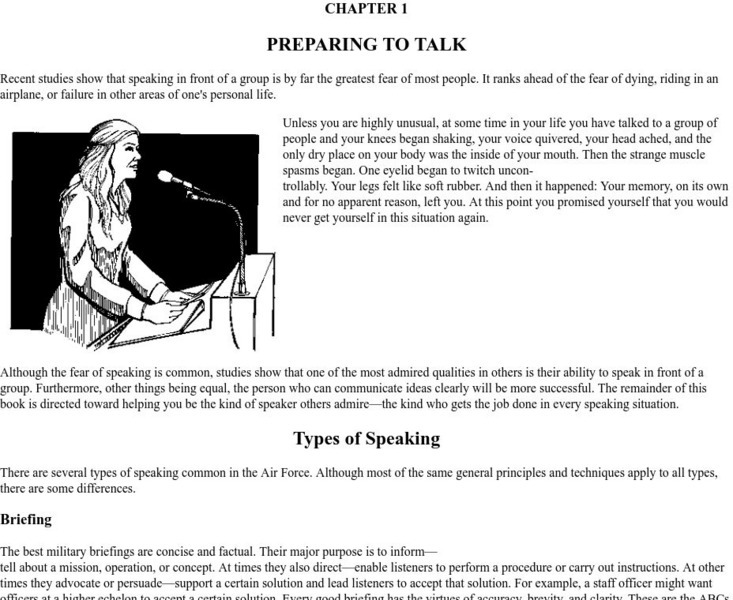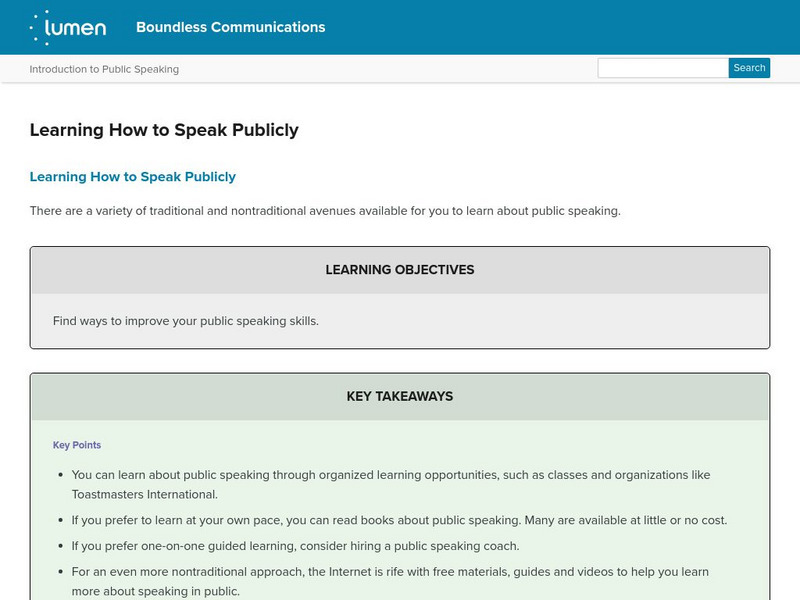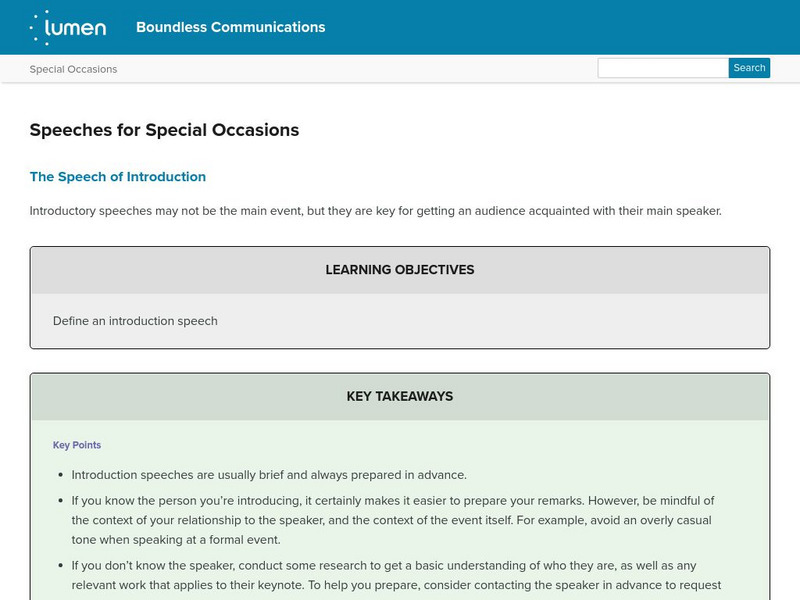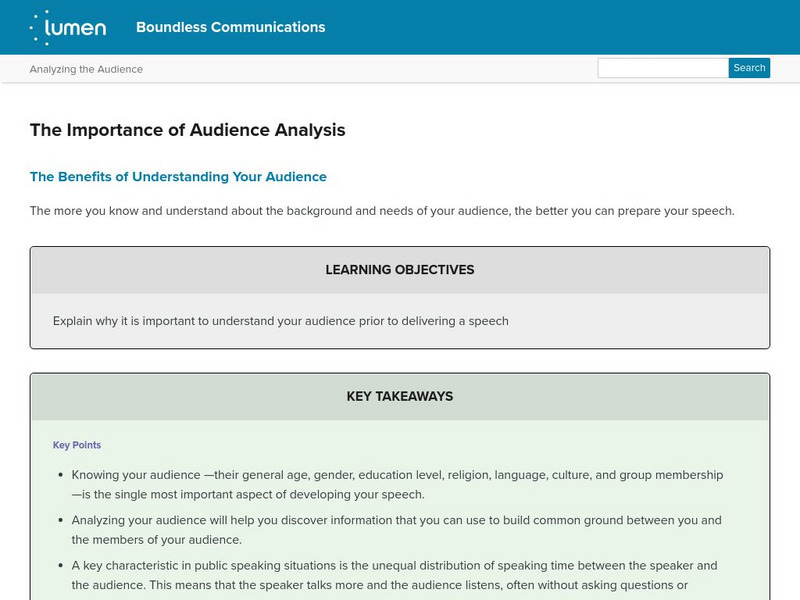ReadWriteThink
Read Write Think: Developing, Writing, and Evaluating Persuasive Speeches
Contains plans for four lessons that teach students how to make and present strong persuasive speeches. In addition to objectives and standards, this instructional plan contains links to sites used in the lessons as well as assessment...
TES Global
Blendspace: Effective Communication
A learning module with links to texts, images, and videos on how to communicate effectively.
Other
Ecg Coaching: Clean the Wax From Your Words
This article will give you a good idea of what to avoid in your speech writing. It deals with specific words and types of words that you should not use. Visit here to polish your speech.
Leaf Group
E How: How to Write a Talking Points Paper
This article by Byron Walsh focuses on writing a talking points paper for a public speaker which consists of researched, accurate information provided in bulleted lists with follow up sentences on specific topics.
Scholastic
Scholastic: Tips From the Insiders
This resource gives six great pointers for creating your speech. It highlights including your information withing stories and andectotes in order to maintain the audience's attention.
Sophia Learning
Sophia: Determining Your Audience
On this website you will find information, two presentations, and a practice worksheet explaining how to decide the audience of a written piece and how to appeal to an intended or general audience in an original text....
McMaster University
Mc Master University: Making Class Presentations [Pdf]
Comprehensive guide with 17 areas of suggestions and tips for delivering a successful class presentation. Requires Adobe Reader. [PDF] CCSS.ELA-Literacy.CCRA.SL.4, SL.11-12.4 Presentation
Sophia Learning
Sophia: Expository Speeches
This lesson is a fun way to practice the elaboration tools needed to back up answers. Students will need to speak about a random topic for one minute without time to prepare. This lesson helps students practice their speaking skills,...
University of Michigan
Univ of Michigan: 4 Ps: Plan, Prepare, Practice and Present Your Speech [Pdf]
An outline for designing an effective speech is provided on this site. Steps included in the outline consist of the following: planning to write the speech; preparing to present the speech; and delivery of the speech. SL.9-10.1a...
Other
Air War College: Speaking Effectively: Preparing to Talk
Use tips from this experienced speaker to help you get through the jitters of public speaking. Explains how to assess your audience and adapt your presentation, how to choose a focus, and how to establish your purpose.
Sophia Learning
Sophia: Writing for an Audience
A seven-slide presentation discussing the importance of writing to an audience in order to establish tone, strengthen word choice, and determine what supporting details to include.
ReadWriteThink
Read Write Think: Oral Presentation Rubric [Pdf]
This reproducible resource provides an assessment rubric to be used with students' oral presentations. CCSS.ELA-Literacy.CCRA.SL.4
Wisc-Online
Wisc Online: Concluding Your Speech
The conclusion of a speech is your last chance to stress your main idea and purpose. How can you make it memorable? Follow these guidelines to write a strong conclusion to a speech.
Wisc-Online
Wisc Online: Introducing Your Speech
Follow these do's and don'ts of writing an effective introduction to a speech that will grab your audience's attention and state your central idea. Use the arrows to move through the information.
Texas Education Agency
Texas Gateway: Organization Appropriate to Purpose, Audience, and Context
[Accessible by TX Educators. Free Registration/Login Required] Write an essay that is organized appropriate to audience, purpose, and context.
Lumen Learning
Lumen: Boundless Communications: Learning How to Speak Publicly
This site provides a variety of ways for people learn how to speak publicly and the best practices in preparing and presenting speeches. SL.9-10.4 Presentation
Lumen Learning
Lumen: Boundless Communications: Speeches for Special Occasions
This lesson focuses on speeches for special occasions including, introduction speeches, goodwill speeches, inspirational speeches, acceptance and presentation speeches, dedications and eulogies, and farewells, toasts, and after-dinner...
Lumen Learning
Lumen: Boundless Communications: Establishing a Purpose and a Thesis
This lesson focuses on establishing the purpose and thesis of your speech. It includes information about both a general and specific purpose of the speech and developing a thesis statement that clearly articulates the purpose and main...
Lumen Learning
Lumen: Boundless Communications: The Importance of Audience Analysis
This lesson focuses on analyzing your audience including the benefits of understanding your audience, what to look for, how to identify with your audience, and tips for the speaker.
Lumen Learning
Lumen: Boundless Communications: Contextual Factors to Consider
This lesson focuses on contextual factors to consider when analyzing your audience including physical contexts, values, beliefs, attitudes, and needs, audience opinion of you and your topic, and audience knowledge of your topic.
Lumen Learning
Lumen: Boundless Communications: Adapting to Your Audience
This lesson plan focuses on adapting your speech to your audience including analyzing your audience using direct observation, interviews, surveys, or Likert rating scales and then apply knowledge about the audience to adjust the message...
Lumen Learning
Lumen: Boundless Communications: Elements of Speech Communication
This lesson discusses the elements of speech communication including the speaker, message, types of channels, audience, and feedback.
Lumen Learning
Lumen: Boundless Communications: Types of Public Speeches
This lesson focuses on the types of public speeches including informative, persuasive, and speeches for special occasions. It also discusses the difference between informative and persuasive speeches. SL.11-12.6 Speaking tasks
Lumen Learning
Lumen: Boundless Communications: Components of a Speech
This lesson focuses on the components of a speech and what is included in each section. It includes the introduction, body, conclusion, and transitions.








![Mc Master University: Making Class Presentations [Pdf] Handout Mc Master University: Making Class Presentations [Pdf] Handout](https://d15y2dacu3jp90.cloudfront.net/images/attachment_defaults/resource/large/FPO-knovation.png)

![Univ of Michigan: 4 Ps: Plan, Prepare, Practice and Present Your Speech [Pdf] Handout Univ of Michigan: 4 Ps: Plan, Prepare, Practice and Present Your Speech [Pdf] Handout](https://content.lessonplanet.com/knovation/original/233880-0709742bec31ef68ca8e08d41f97bb61.jpg?1661556076)













